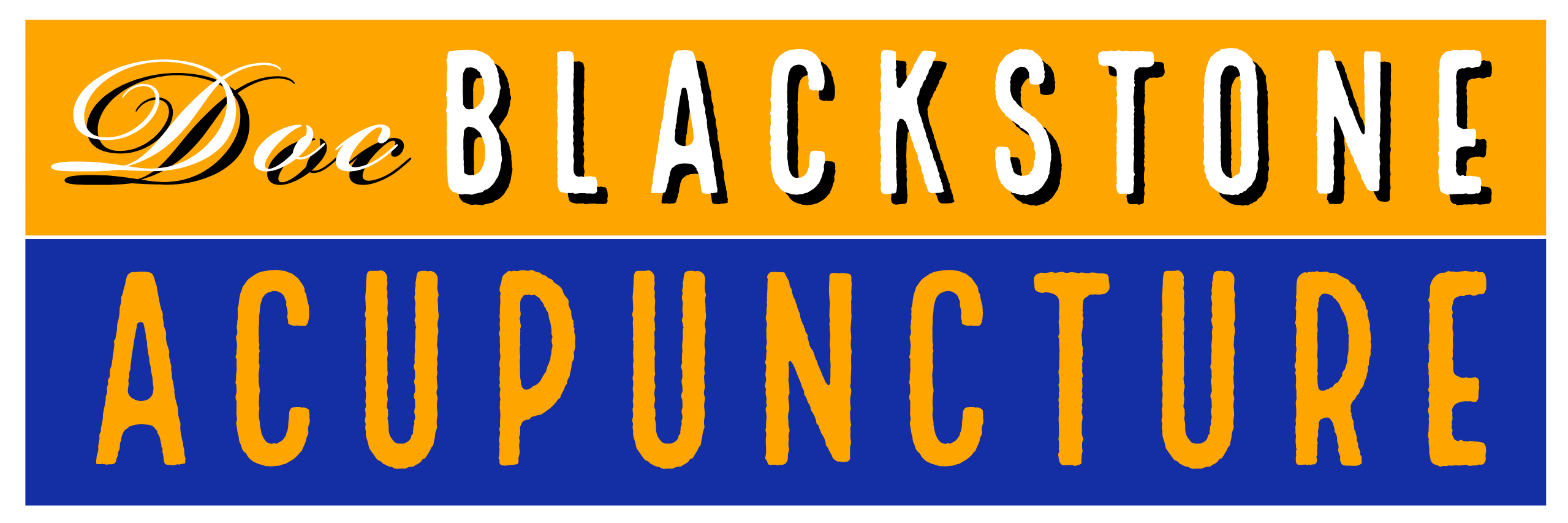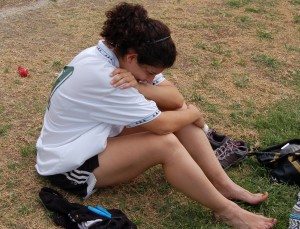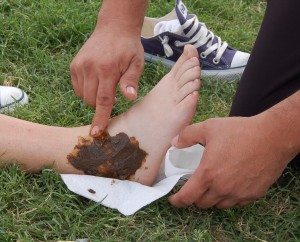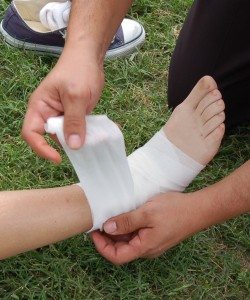“And the Grinch, with his Grinch feet ice cold in the snow,
stood puzzling and puzzling, TCM Sports Medicine:”Ice for an injury, how could it be so?” ~ Dr. Seuss
Now, Dr. Seuss isn’t a sports medicine physician, but if you ever find yourself sitting with an ice pack on an injury, you should be asking yourself, “Why, WHY?”.
“Ice restricts blood flow, impeding the natural healing process, prolonging recovery, and increasing the likelihood of recurring injuries.” TCM Sports Medicine:”Ice for an Injury. How Could It Be So?”
When a sprain, strain, or contusion is incurred, soft tissues are damaged, and blood from the ruptured capillaries leaks out under the skin and pools, causing the area to swell and form a red or purplish mark that can be sore and tender to touch. After an injury, blood vessels that deliver oxygen and nutrients to cells are damaged. The cells around the injury increase their metabolism in an effort to provide more oxygen. When all of the oxygen is used up, the cells die. Blood cells and fluid seep into spaces around the muscle, resulting in swelling and bruising as dead cells accumulate. TCM Sports Medicine: “Ice for an Injury. How Could It Be So?” This is common medical knowledge.
When ice is applied to an injury…TCM Sports Medicine:” Ice for an Injury. How Could It Be So?”
Ice reduces swelling by lowering the temperature of the damaged tissue through heat exchange, causing local blood vessels to constrict. Metabolism slows, reducing the delivery of oxygen and vital nutrients to the affected area. Constricted blood vessels and a slowed metabolism cause blood and fluids to accumulate and stagnate in the area, contributing to localized pain. Ice numbs nerve endings, limiting the transfer of impulses to the brain that register as pain. TCM Sports Medicine:” Ice for an Injury. How Could It Be So?”
When explained in this way, does the application of ice to an injury sound like it helps or hinders? Well, then, what are the options?
For over 25 years, I have successfully employed Traditional Chinese Medicine therapies to quickly restore strength, mobility, speed, flexibility, and confidence to injured athletes. From a Chinese Medicine point of view, the smooth and continuous flow of Qi and “vital fluids” must be maintained in order to heal quickly and remain healthy. The following is my personal regimen to ensure a speedy and complete recovery from any sprain, strain, or contusion. Originally, I was trying to come up with an acronym (like R.I.C.E.) so that the procedures could be easily memorized, but the steps already make common sense. Memorization is no substitute for sensibility.
“The use of ice for the treatment of sports injuries is contradictory to the natural healing process! Forget the acronym RICE!”
Initial Evaluation
The first step in managing any injury is obtaining an accurate and immediate initial assessment. Part of obtaining an accurate assessment is understanding the nature of the injury—what happened and how. Was the injury from an impact or a fall? Was the injured area twisted, pulled, or hyperextended? The severity of a sports injury increases cause for concern and the need for immediate first aid. Conduct a visual examination. Check for any unusual deformities. Is it painful to move? Is it painful to touch? Ask if there is numbness; this may be especially important if the symptom persists.
Next, palpate the area of injury and look at the anatomy, checking for a discontinuity in key sections of the muscle to make sure the muscle is continuous. Slowly and carefully check for movement and stability.
If there is any question about the severity of any injury, seek medical assistance immediately. If you really feel there is something wrong and you’re not sure what, don’t wait to get medical attention!
Topical Application.. ( TCM Sports Medicine:”Ice for an Injury. How Could It Be So?” )
The immediate treatment of any significant soft tissue injury is vital. Proper care and immediate treatment can significantly decrease recovery time and the possibility of complications!
Apply San Huang San liberally to the affected area and wrap with roll gauze or cover with an adhesive gauze pad to keep the paste in place. Leave the wrap in place for 12 to 24 hours, depending on the severity. Do not wrap tightly!
San Huang San is an ancient Chinese topical preparation that mildly invigorates the blood, thus reducing swelling at the site of an acute sprain, strain, or contusion. The actions of this herbal combination accelerate the natural healing process. Variations of the formula often have other herbs added to move blood and reduce pain. A finely prepared rendering of this formula is marketed as MHS San Huang San 3 Yellow Powder. It can be purchased in pre-mixed form, ready for immediate use, at modernherbshop.com. I have used the product from Modern Herb Shop myself and confidently recommend it.
Warning! This preparation often works so well that there may be no signs of swelling, bruising, or pain shortly after application. The application of San Huang San is a first-aid measure only, not an immediate cure! The injury still needs time to heal. The application of San Huang San is one step towards decreasing the length of time it takes to heal.
Elevation
Elevation can play a minor role in the movement of blood away from the injured area and lessen swelling. This can be done at any time.
Rest
Rest for the first 24 hours. Avoid the inclination to continue to run, walk, or continue normal activity! It takes time to heal. Movement should be kept to a comfortable minimum. If there is still mild pain and swelling 24 hours after the injury, reapply San Huang San and wrap gently with gauze for another 12 to 24 hours. Keep in mind that the wrap is not for the purpose of compression, just to hold the San Huang San paste in place. If the injury is properly assessed and San Huang San is applied immediately, swelling should be entirely subsided with little or no pain after 48 hours.
In the rare case that the skin should become irritated, discontinue use and switch to massage or hot bath* in place of San Huang San. (See “Other Alternatives”).
Test
After the San Huang San has been applied for a maximum of 48 hours, wash off the San Huang San with warm water. Test the injured area. Begin by gently pressing around the affected area. Does it hurt? There should be little or no pain. Slowly and gently check the movement and range of motion. Next, check to see if the injured area will support normal weight. If the injury passes these tests, it would be most advantageous to begin a massage or Asian bodywork regimen.
If there are any questions as to the severity of the injury at this point, consult a doctor or experienced healthcare professional! TCM Sports Medicine: “Ice for an Injury. How Could It Be So?”
Asian Bodywork Therapy
Begin a daily bodywork regimen as soon as possible after the first 24 hours. If the resources are not immediately available to permit the application of topical herbs and the injury is not severe, gentle bodywork should commence immediately.
Manual manipulation will ensure proper circulation at deeper levels, retention of range of motion and flexibility, limit complications, and speed up the healing process. Restoring and maintaining healthy blood flow will help mend tissues and eliminate scarring and the formation of adhesions, reducing the possibility of chronic injury to the area. It is important that the bodywork or massage not be strictly localized but should include the connecting muscles and tissues, keeping in mind that the idea is to accelerate the flow of Qi and vital fluids.
Recovery process
Mild stretching should be included in this part of the recovery process. There are certain liniments that I use during this stage, but they are not absolutely necessary in all cases. It is highly desirable to have an experienced professional perform your bodywork. An expert can easily locate and focus on areas that require attention.
It is important at every stage to listen to your body. It is crucial not to do any activity that will cause additional damage to the injured area. Of course, you may feel some discomfort but do not push yourself to the point where you’re feeling sharp pain. Trying to do too much too soon can have drastic negative results.
Be sure to drink extra fluids during your injury recovery. Fluids are necessary to repair and rebuild soft tissue. The extra fluid will help expedite the natural healing process.
LIGHT USE
Everyday activities that do not include training may be resumed when there is no pain, swelling, or impediment to range of motion with normal flexibility. Light activity will promote overall blood circulation and expedite the removal of waste products, i.e., dead cellular material, from the injured area. Continue to consume more fluids than normal to facilitate this process.
The strengthening phase may commence once light activity can be easily tolerated. The amount of time it takes to reach each stage towards complete recovery will vary from person to person. Asian Bodywork Therapy or massage should continue to be administered daily.
Strengthening
As tempting as it may seem to jump right back into a sports activity, I do not recommend skipping this step. With proper first-aid and post-injury care, the wounded area can be made stronger and more sound than before the injury. A strengthening regimen should include methods appropriate for your sport. TCM Sports Medicine:”Ice for an Injury. How Could It Be So?”
If you continue to have the same type of injuries to tendons and/or ligaments, I highly recommend seeking advice from a practitioner of Traditional Chinese Medicine. All too often, I see imbalances related to the Liver and Gall Bladder (meridians) that are the root cause of this type of injury. No Western medical doctor will be able to find any correlation to this statement in their medical books.
Recovery
Return to normal training and participation in sports can ensue after the injury has had sufficient time to heal properly and reconditioning has been satisfactorily accomplished.
You should strive for nothing less than a fully restored range of motion, flexibility, and strength without any notable impingement. If injury is still apparent, slow down and digress a step or two rather than risk injury.
There’s no true way to do a comparative study to see how much better my methods are than other alternatives. But I’ll say this: I’ve done hundreds of evaluations over the years. I’ve seen sprains, strains, and contusions treated with ice and the exact same injuries treated using my methods. Using my methods, herbs, and techniques, the time it would typically take to recover from any sprain, strain, or contusion can be cut in half.
The length of time it takes to go through this whole process can take as few as 3 days, up to 3 weeks, or slightly longer.
*Other Alternatives- TCM Sports Medicine:”Ice for an Injury. How Could It Be So?”
If San Huang San is not available, begin gentle massage immediately and keep the injured area warm in any way possible. The ideal way to administer therapy on a zero budget is to massage from beyond the injured area towards the heart in a hot bath.
Technique: Use strokes similar to what you would if you could imagine yourself trying to squeeze toothpaste from a giant tube, squeezing gently from beyond the injured area and pushing towards the heart.
Logic: Massage strokes from beyond the injured area towards the heart increase local circulation and aid venous blood flow and the flow of lymph fluid. Thus, dead cellular material is carried away more efficiently. Drinking plenty of fluids will further assist this process.
If you have Epsom salts, add 2-3 cups to the bath. Despite conjecture to the contrary, I have found this useful in reducing aches and pains.
NOTE: Those of you who like it hot may already know that it is much more comfortable to draw a really hot bath if you seat yourself in the bathtub containing moderately hot water and then increase the hot water gradually until the desired temperature is reached. Hot baths may be taken several times daily, provided precautions are taken to keep from “catching a cold”. Stay adequately covered so as not to expose yourself to a sudden cold or blowing air right after a bath, specifically the back of the neck and feet. TCM Sports Medicine:”Ice for an Injury. How Could It Be So?”
CONCLUSION
TCM Sports Medicine:” Ice for an Injury. How Could It Be So?” Ice does not promote healing in any way. The application of ice to any injury impedes the natural healing process. Ice can also induce chronic pain because the treated area will not heal properly. There are better alternatives.
Use San Huang San for your sprains, strains, and bruises. Save the ice for the beer and hot dogs. Visit your local Asian Bodywork Therapist for help with conditions beyond the scope of this article. To find a certified Asian Bodywork Therapist in your area, check the AOBTA registry at aobta.org.
.
.
Special thanks to Yvonne, Natalie, Heather, and the women of the San Antonio Extreme Heat women’s soccer team.










